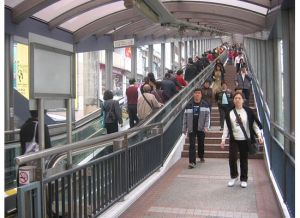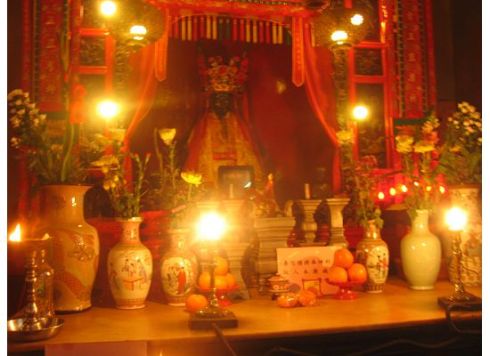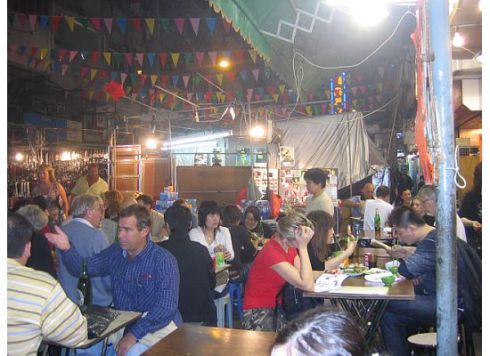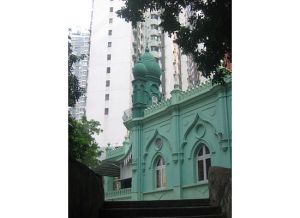I APOLOGIZE for the mess,” the owner of OPT Art Gallery says with a smile. She is wearing a loose white shirt and a comfortable air that match the ambience of the small space where she is showing the work of Taiwanese artist Chiou Jyian-Ren. Middle-aged and British, she is chatty and charmingly harried and has just finished holding a drawing class in the gallery’s central space. “I’ve been too lazy to clean up,” she confesses.
“Isn’t he lovely?” the gallery owner enquires, looking at the paintings that line her white walls. I gaze at them, enjoying the moment of quiet. There is no one else there but she and I, and the sun does not poke its inquisitive rays into the cool interiors of the gallery.
OPT is one of the many art galleries around Hong Kong island’s Mid-Levels Escalators. These moving metallic steps are the most convenient way to get from the bottom of the hilly terrain in the downtown financial Central district, to Conduit Road, halfway to the top.
At 800 metres, it’s also the longest outdoor covered escalator in the world, comprising 20 separate escalators and three moving sidewalks. It takes Hong Kong’s busy commuters 20 minutes to travel the 135 vertical metres from top to bottom. During the morning rush hour, it runs downhill so that people can get to work, and then operates uphill till midnight.
For the Hong Kong authorities, the Mid-Levels Escalators were an ingenious way to reduce traffic congestion and air pollution. Built in 1993 at a cost of HK$240 million (about Rs123 crore) to encourage people to walk to work, it is used by roughly half a lakh people every day.
I ride the plastic grey snake for pleasure. The true delight of the escalator lies in the streets and terraces it introduces to its passengers. This part of Hong Kong is wrapped around a small hill, at the top of which is a nature park and the famous lookout point, Victoria Peak. Streets curl around the hill; the escalator cuts through them. At each level, it brakes for those who wish to get off.
The first stop is Wellington and Cochrane Street, which boasts of a jade centre, a reflexology centre and lots of Chinese eateries. Locals throng the restaurants, usually forming serpentine queues outside each establishment. The food is cheap, the service is swift and the location can’t be beaten. This is a crowded area, especially around lunchtime.
A little above street level is where the famous Linva Tailor/Fashion is located. “What size are you looking for? We have every colour,” the cheongsam-clad Chinese woman behind the counter informs me. A saleswoman follows me around as I browse through the rows of glittering, colourful dresses. Regretfully, I step out empty-handed. The city’s most famous maker of the Chinese cheongsam is not cheap. Expect to pay a minimum of HK$2,500 for one of Linva’s ready-made dresses.
The next stop is Upper Lascar Row, to be avoided by the squeamish. Even though I am non-vegetarian, my skin crawls as I plunge through the rows of stalls offering fresh meat on the street. Animals hang in windows of enclosed shops; butchers practise their art for a mainly female audience; old women with stern faces offer fresh fish and live crabs for my delectation. They babble at me in Cantonese, the language that is spoken in Hong Kong and in China’s Guangdong province.
I am eager to move on, and Hollywood Road is the perfect distraction. In guidebooks, it’s often listed as the place to shop for antiques.
But the cheaper the price tags get, the less likely it is that you’re looking at an antique. It is best to shop in proper galleries if you don’t want to be ripped off.
I follow Hollywood Road to Man Mo Temple, a popular tourist destination. The road winds downward, and this is at least a 10-minute walk. Man and Mo are the names of two gods. Man means ‘civil’, Mo, ‘martial’. The temple was built in 1847 AD, the 27th year of emperor Daoguang, of the Qing Dynasty.
I enter with a busload of international tourists. On the left is a large glass case that holds two ornate, gold-plated teakwood chairs. These were used to carry the gods’ statues during parades. Rows and rows of dark yellow incense coils hang from the ceiling, curling as the streets do around Hong Kong’s hills. The coils emanate a thick cloud of smoke that ruins most amateur photographs (including mine). On the right, there’s a donation box and a gong; visitors who strike the round red gong must drop a few Hong Kong dollars into the box.
In the front, there are statues of Chinese gods. Worshippers—and there are many—kneel in front of the statues, incense sticks in their hands, which are joined and raised in prayer. I come out of the temple with smoke in my eyes and the colour red lingering in my vision (red is considered auspicious by the Chinese).
On the way back, to the escalator is Indosiam, a bookstore with Hong Kong’s best collection of rare books on Asia. Further along, Jashan, one of the city’s best Mughlai restaurants, tempts me, even though it’s a long way to lunchtime.
As we move, the streets begin to change character. There are almost no Chinese eateries this high up. Restaurants here are classier or cater to a more westernized palate. The next street is Staunton. This is the beginning of SoHo, which mirrors New York’s chic neighbourhood by the same name. It’s where the expats go for food and wine. On Elgin Street are some of Hong Kong’s best restaurants, including Havana, which does excellent cocktails and Caribbean-style tapas.
Higher up is the simple green Jamia mosque, which lends its name to Mosque Street. The walled courtyard offers greatly needed space in the crowded constructions of Hong Kong. The environs are quiet and leafy, but the minute I look up, skyscrapers dwarf the clean lines of the minaret.
The higher I go, the less interesting the vistas get. The escalators are steep now, and I am grateful for them. Two cats are curled up on the window seat of a building I pass by. I envy them.
The next stop is not a street, just a rest stop for the weary, with two benches and a few tired-looking trees. Two more escalators take you to the Mid-Levels and Conduit Road. That’s where the escalator ends. Your journey doesn’t have to. Turn left and keep walking to reach the Hong Kong Zoological and Botanical Gardens. If you do, you have more stamina than I.
TRIP PLANNER
How to go
Flights: Cathay Pacific flies from Mumbai (return economy fare: Rs32,000) and Delhi (return economy fare: Rs27,000).
Visas: Hong Kong gives visas on arrival to Indian tourists staying not more than 14 days.
Where to stay
We stayed at the Ritz-Carlton Hotel in Central district, Hong Kong Island (T: +852 2877 6666, HK$2,880 onwards). For HK$250 onwards, bath stewards will draw a bath for you. Options include the scented Lady’s Bath with red rose petals, served with fresh veggies, a freshly squeezed juice of your choice, a compress and soothing eye-mask. The Gentleman’s Bath comes with cognac and a cigar, the Honeymooners’ Bath with expensive champagne, and strawberries with chocolate and cream. The Mandarin Oriental, two minutes away, is a modern hotel that oozes luxury (T: +852 2522 0111, HK$2,900 onwards). For cheaper options, consider the island of Kowloon. The Metropark Kowloon Hotel is a more affordable option (T: +852 2761 1711, HK$1,050 onwards per night).
What to eat
Visit a Chinese restaurant for a dim sum lunch (try the Chiu Chow Garden in Jardine House) and for congee (a type of rice porridge). Restaurants that have throngs of people waiting outside are generally a good bet.
What to do
Shop! Check out Linva Tailor/Fashion for Chinese cheongsams, or Hollywood Road for affordable antiques. The street markets in Kowloon make for an interesting walk. Choose from the flower market, bird market, Temple Street night market, and many more.
Victoria Peak on Hong Kong Island is another must-do. Hike up Conduit Road to the peak if you want a good workout, or just take the tram. There is an observatory at the top, as well as several restaurants if you’re feeling peckish.
This article was published on 19 May 2007 in the Indian newspaper Mint.










Leave a comment